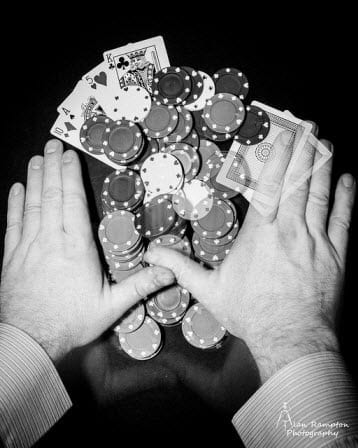In this article, I will be covering 6 trade management strategies for preventing traders from taking all-in trades. Before I dig into the details of each step, let us first come to an understanding of what is an “all-in” trade.
What is an all-in trade?

All-in Trade
The way I am framing “all-in” for this article, is where a trader is looking to strike it big overnight.
For my riverboat gamblers and traders that laugh at the idea of stops or money management, all-in trades do not require a definition because it is such common practice for your trading styles.
For those of you out there that are unfamiliar with the term all-in, it essentially means you have committed so much of your capital to one position, that the position can literally make you or break you.
When I say, “break you”, I am not implying a slight bump in the financial road. I am saying your account will literally go from $100k down to $20k in a short period of time.
This brings me to my next point regarding all-in trades. These are high volatility trades where a stock can move up or down quickly. For example, pouring all of your funds into a new IPO of a small company or backing up the truck on a biotech awaiting phase 3 approval from the FDA.
Even for blue chips, which may seem infallible to the risks of an all-in trade, below is a list of sure stocks that ended up ruining people’s lives:
- Enron
- Lehman Brothers
- Global Crossing
- World Com
Now that we are all grounded on what is an all-in trade, let us start digging into the 6 steps that can save you a lot of headache.
Step 1: First understand how you let the trade get out of hand
This may sound like an unnecessary step as you are presently in the trade and seeing how the past can help at this point can feel like a waste of time. However, it is important to know how you have ended up in an all-in trade, in order to navigate your way out of such a precarious position and to ensure you never commit such a trading error in the future (Step 6).
Please take a few minutes to examine each scenario provided below to identify which scenario best fits your situation. This will be critical later in how we deal with the root cause of the issue, so we can eliminate this destructive behavior pattern from your psyche.
Scenario 1 – Did you open the position in hopes of hitting it big with a home run trade?

Home Run Trade
You need to realize that there are no free lunches in the market. For every stock that soars 400%, there are another 100 that do not come anywhere near those types of returns. Seeking quick gains is a sure way to hand over your hard-earned money to traders that are more skilled.
Scenario 2 – Did someone else talk you into taking the position and you felt like it was such a sure bet you could not stop yourself from making the easy money?
Taking advice from others can feel like the right thing because it transfers responsibility of your trading actions onto someone else. Making money this way will feel great when things are going your way; however, the minute things go south, you will be frantically looking for a life raft. The reason being, you never fully understood why you were taking the trade in the first place and without a winning attitude and nerves of steel, the market will always find a way to separate you from your money.
Scenario 3 – Did you start out with proper money management techniques, but kept averaging down on the trade so much that you found yourself with a concentrated position?
This is likely one of the toughest root causes for being over leveraged. You were fighting the market, or trying to average down and things got out of hand. You were not looking to strike gold or using someone else’s advice to make it big. You were simply trying to manage your way out of a bad situation and things got worst.
Do any of these scenarios sound like you or a variation of you? Please remember to be honest, as you are thinking through how you ended up all-in on the trade.
Step 2: Embrace the Risk or Fold’em
The decision my friend is never easy, but must be all yours and no one else’s. The logical response to holding an all-in position is to fold’em and live to fight another day. However, what if you have already taken a sizeable loss in the trade, or what if you have played it safe for years and you are willing to take the risk on this one stock.
Regardless of how afraid you may or may not be, the key is taking a stance and sticking to it no matter what.
If you elect to reach deep and let it ride, then let it ride. You cannot begin second-guessing yourself and overreacting to every tick. If you micromanage the position, you will find a way to sabotage the trade and completely ruin your potentially life changing event.
If you elect to close the position or reduce your exposure (highly recommended for any long-term trading success), then do so and never look back. Do not take the conservative route and then monitor your old position everyday as if you are still in the trade. Especially do not beat yourself up if the stock actually goes to the moon after you closed or reduced your position. Remember, large winning trades can still be bad trades because you violated your rules.
Step 3: Learn to Manage Your Emotions
You are going to have a heightened sense of emotions like those that you have not felt before in your life when holding an all-in position. Your emotions will ride up or down based on how the stock performs on a given day, hour or even minute. The grip the position will hold on your life is indescribable.
So, as you are reading this article, remember there are really two emotional levels you will have to endure:
- the short-term emotional swings you will experience while holding the position
- after the position is closed you will need to emotionally accept the outcomes of your poor decisions (good or bad)
Step 4: Have a set exit target
Trading all-in will bring about the greed and fear in your soul as if you are being chased by a bear in the wilderness. The only way to control this is to have a set target where you will exit the trade no matter what.
Now, if the trade is not working out, your target will likely be somewhat realistic as you have been humbled through the experience. If you are on the other side of the trade and things are going well, you will start to develop such lofty targets that your future rewards will be hefty enough to take care of your family for generations to come.
So, herein lies the challenge, how do you effectively set a target that will make the risk worth your time?
I cannot answer this one for you, sorry. The best thing you can do is set a realistic target, enter your order and when that number is reached, exit the position and never look back.
For me, I would use a point and figure target and choose the lowest achievable price target as my first level to consider exiting the position. Once the target is achieved, I would then watch the stock like a hawk to determine when to exit the position.
Step 5: Immediately take a break from trading
After you close an all-in trade, you will need to take a break from trading. Homerun trades not only work a number on your bank account, this type of trading behavior will also take a toll on your personal well-being and will negatively impact your closest relationships.
The other reason for taking the break is you need to grasp the horrible position you placed yourself in, regardless of the root cause. Obviously, if the trade went against you, you may feel like you need to just checkout to build back up your confidence. However, if the trade is wildly successful, this is also a reason to take a break from the market. Inexperienced traders lose the most money after reaching a euphoric peak in their account balance.
Trust me when I say the money will leave you just as quickly as you were able to earn it if you do not take a breather.
Depending on the level of risk you were carrying should dictate the amount of time you step away from the market. If things really got out of control, you should likely take 2-3 months to clear your head and to work on setting up safeguards, which we will cover in the next section to ensure you eliminate that part of you that takes all-in trades.
Step 6: How to implement safeguards so you never take another all-in trade

Man in the Mirror
When I was in my early 20s, I had a concentrated position in Dow call options back in 2003. I literally had an opportunity to turn $40k into over $2M in a little under 12 months. Needless to say, greed consumed me and instead of taking $250k to over $2M by executing my trading plan, I decided to chase a few more thousand and ended up missing my life changing opportunity.
After blowing this trade, I still dabbled in options until late 2006 when I managed to blow another $25k. After this blunder, I found myself looking in the mirror and asking the tough question of “what the hell are you doing?”
The fact I was even asking myself this question led me to close out my options account. I knew then as I know now, options trading brings out the greedy part of my psyche, which is not conducive to making consistent money.
I began to embrace the fact that time was on my side and with a sound investment strategy, I can accumulate significant wealth without the stress.
Now that you have listened to me on my soapbox, let us talk through some basic steps you can take to prevent yourself from going all-in on a trade.
Remember in Step 1 where we identified a number of scenarios leading to all-in trades, well now we can start to peel back each one to provide steps to prevent their occurrence in the future.
Scenario 1: Did you open the position in hopes of hitting it big with a home run trade?
If this is you, your issues are not with trading, but something else in your life. Either you are seeking a quick thrill or the idea of freedom has you taking unfathomable risks in the hopes of hitting it big. While this can happen, the odds are not in your favor. Below are some of the reasons in your mind that could be pushing you to take the home run trade:
- You believe you are special and will easily climb into the top 1 percent of all earners without doing much work (this should strike a chord with any millennials reading this article)
- You are not satisfied in your job. Like many people, your job provides you sustenance for survival but is not your life’s purpose. The idea of hitting it big and telling your boss to pound sand can take you to some pretty far heights in fantasy land
- The idea of taking years to build up your trading capital feel like a waste of time
If this is you, the first thing you should do is stop trading for 2 to 3 months. You need to figure out why you are really in the business of trading. There is trading for a hobby or cheap thrills and then there is trading for a living. As long as you continue to swing for the fences, there will be disciplined trader on the other side of the trade to take your money.
Scenario 2: Did someone else talk you into taking the position and you felt like it was such a sure bet you could not stop yourself from making the easy money?
These are the worst type of riverboat gamblers in my opinion. Not to beat up on this group too much, but if you are going to take huge risks with your own money, do not take the coward approach and use someone else’s advice.
If you fall into this category below are a few steps you can take to ensure you never end up in an all-in trade again:
- Cancel all stock advisory subscription services
- Stop cruising chat rooms and social stock sites looking for hot tips
- Remove margin from your trading account if swing trading
- If day trading, only use 10% of your available trading margin on a position
Scenario 3: Averaging down has gotten completely out of control
If you find yourself all-in on a position because of averaging down, below are some simple trade management techniques you can use to get back on track:
- Stop averaging down; your issue is with identifying the appropriate entry point.
- Accept that a percentage of your trades are just going to be losers. Averaging down is another way of saying you have to be right on every trade.
Now that I have listed the 6 steps for how to effectively manage an all-in trade, I now need to take a quick detour and go on a personal rant.
All-In Trades Rob Us of Great Traders
As we mentioned earlier in this article, trading is one of the few professions that you can commit a disastrous act in seconds that can ruin years of hard work. This sad reality I believe robs the trading community of great talents on a daily basis.
It pains me when I encounter traders that can go on a 6-month run and then lose it all and more in a week.
It is one thing if a trader will never achieve their dream, but for the trader that is so close to touching the mountaintop, only to be slapped back by a trade that got away is something I hope we as a community can help defeat.
The Literary and Blogging Community Also Needs to Take Some Responsibility
I get that the internet is meant to be the ultimate destination for freedom of expression, but there are social and moral obligations that we as a trading community need to start holding authors accountable to.
My loving wife, who continues to support me through this journey of mastering trading, sent me a link to an article the other day about the top trading hoaxes for 2014.
The Forbes article titled ‘Top 5 stock market hoaxes of 2014’ did a great job of quickly describing how a few so-called traders were able to deceive so many.
Out of these stories, 3 of them really got my goat. The first was a story of a kid that somehow managed to make $72 million trading while still in high school. Another one talked about the penny stock Cynk that went from a non-existent valuation to over $6 billion. The last described how a blogger/writer for Street.com and Seeking Alpha managed to pump biotechs that he was being paid to promote the companies. Talk about a conflict of interest.
Now, the article only goes as far as to point out that these events were a hoax. However, these types of articles published by reputable companies pushes the greed agenda in the market. Of course, I hold people accountable for their own actions, but these types of articles will push some to take on unnecessary risks and go all-in on a trade with the hopes of hitting it big. I know there was one trader out there that said, if this 17-year old can make $72M, well so can I!
In Conclusion
All-in trades will happen to you at one point or another in your trading career. What separates the hobbyist from the professional traders is that professionals do not take all-in trades under any circumstances.
Remember, if you see someone on the web publishing a post that you know pushes the moral boundaries, do your part and leave a comment or report them to the SEC. Trading is a hard enough business; we do not need people out there pushing garbage. These get rich harmless tweets or 1,000 word blog posts can do more damage to a newbie trader than you can imagine.
Good Luck Trading,
Al
Photo Credit
Poker Chips – Alan Rampton
Home Run – Mike K
Man in the Mirror – Nimshap










 Day Trading Money Management
Day Trading Money Management 
